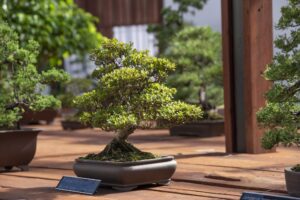New Bonsai House for Brisbane Botanic Gardens
By Dale Arvidsson and Perry Naumann
All images supplied by Brisbane Botanic Gardens Mt Coot-tha
Brisbane Botanic Gardens Mt Coot-tha is Queensland’s premier subtropical botanic gardens and features a variety of spectacular living collections. Many of these themed displays feature categories ranging from geographic to climatic, and conservation to amenity horticulture, which are both educational and inspirational for the Garden’s million-plus visitors annually. One of these special collections is the Bonsai Collection, housed in the stunning new purpose-built Bonsai House.
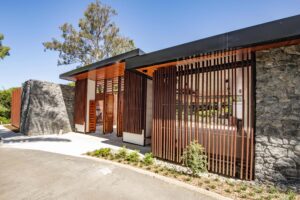
Bonsai is the art of growing ornamental, artificially cultivated trees and shrubs in pots. This Japanese and Chinese art form has been popular for centuries, inspired by nature that has shaped and dwarfed wild trees with harsh winds and poor growing conditions in their natural habitat. Bonsai are cultivated using various specialist techniques to produce miniature specimens which mimic the shape and form of full-sized trees found in the wild.
The original Bonsai House at Brisbane Botanic Gardens Mt Coot-tha was opened in 1999 with the majority of trees donated from the private collection of the late Len Webber, with some trees dating back to 1941. Len was one of Australia’s foremost published authorities on bonsai.
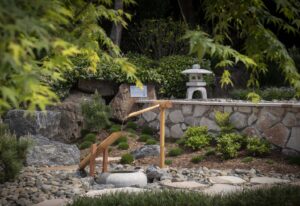
The redesigned Bonsai House was completed and opened in 2022 as part of Brisbane City Council’s commitment to the Brisbane Botanic Gardens Mt Coot-tha Master Plan. The new facility features one of the largest publicly owned bonsai displays in Australia, with a gallery-style layout showcasing around eighty plants on display, a workshop area for training and education, and a contemplation platform for viewing the adjacent Japanese Garden.
The building features recycled and sustainably sourced native timber, including recycled Ironbark, Grey Gum, and Darwin Stringybark timbers, while the iconic Brisbane Bluestone was locally quarried from the Mt Coot-tha Quarry.
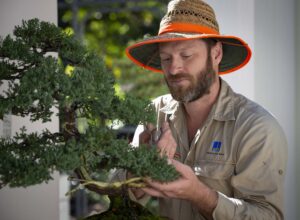
Brisbane’s Sister City – Kobe
The redevelopment of the Bonsai House also commemorates the anniversary of the signing of the Brisbane-Kobe Sister City Agreement on 16 July 1985. In 2020, Kobe and Brisbane celebrated 35 years of strong ties through friendship, mutual understanding, and assistance – particularly in times of natural disaster experienced by both cities. In recognition of the longstanding friendship between the two cities, the Kobe City Government and Kobe City Assembly Japan-Australia Association generously donated a Japanese stone lantern and two Japanese bonsai pots. Brisbane City Council has erected a plaque to mark the occasion and can be seen near the shishi-odoshi water fountain.
The Bonsai Collection
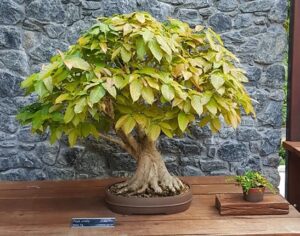
The focus of the collection is on species that can be cultivated in a subtropical climate and features native and exotic plants including figs, conifers, camellias, azaleas, and subtropical deciduous species. Native figs were at the heart of the original Len Webber collection and are still at the centre of the collection today.
The collection is maintained by Botanic Gardens staff and volunteers from the Bonsai Society of Queensland and Bimer Bonsai Club.
The collection
As an educational facility, the Bonsai House display trees in various stages of formation and bonsai still being developed, including trees that have been wired or weighted to shape. This is to educate visitors on how various techniques are used in this art form.
A few examples from the collection include:
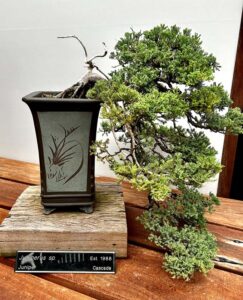
White Fig Ficus virens
Grown from a cutting taken in 1985, this is a beautiful tree that demonstrates excellent root structure. Seasonally, it can be viewed both with and without leaves, with the new growth of this species emerging pink before turning a rusty brown and finally green.
Juniperus sp.
This cascade style juniper was a donation to the collection from a member of the public. It was styled during a demonstration at the annual Bonsai Horizons event in Brisbane by presenter Leigh Taafe from the Australian National Bonsai and Penjing Collection in Canberra. The bonsai artist imagined a tree that had been growing on the side of a mountain, where the apex had died after a heavy season of snow or perhaps a rock striking it. As years went by a new apex formed while the dead branches of its past persisted and were bleached by the elements. The old branches on this tree show ‘jin’ – the bonsai art technique of creating dead, bleached branches to suggest age or damage from the elements.
Swamp Cypress Taxodium distichum
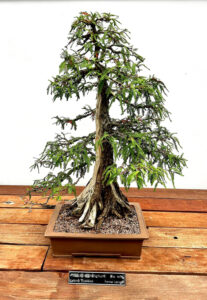
One of the collection’s most impressive trees, this bonsai was donated by Avril and Bob Stanley and established in 1976. The left side of this tree’s trunk is a fine example of ‘shari,’ another term used to describe dead wood on a trunk, which has been carved and bleached to create an impression of age, or perhaps having been struck by lightning.
The Botanic Gardens’ education role is supported by an extensive collection of publications about bonsai available to the public at the Mt Coot-tha Library, also located at Brisbane Botanic Gardens Mt Coot-tha.
The Bonsai House is open daily between 9am-4pm and entry is free. All abilities access is available. For more information on Brisbane’s Botanic Gardens visit www.brisbane.qld.gov.au
Main photo: Inside the Bonsai House Gallery

